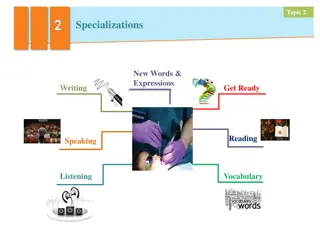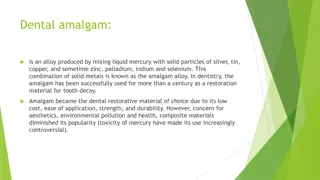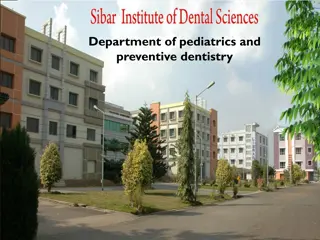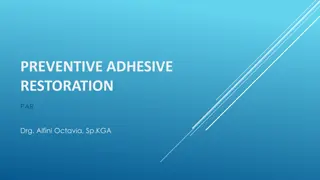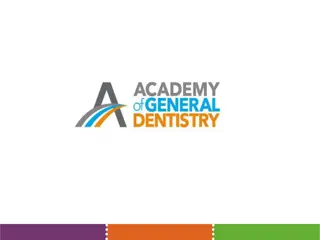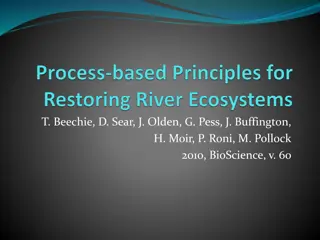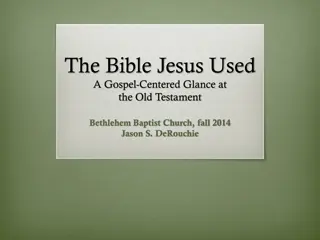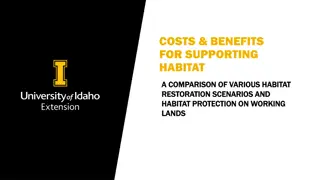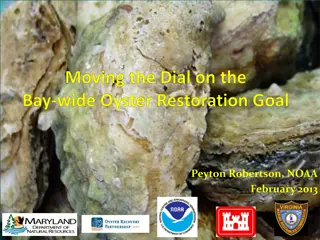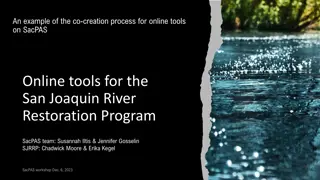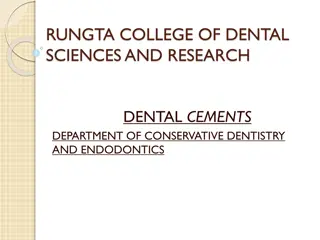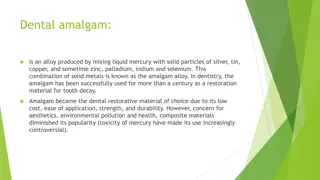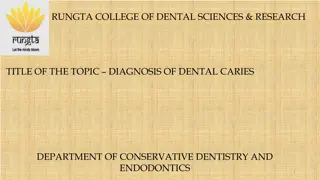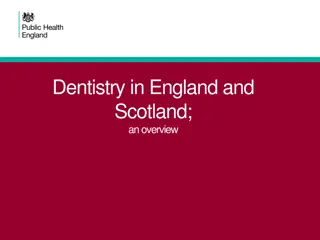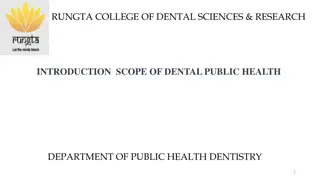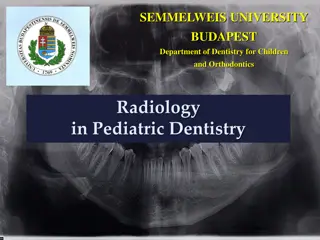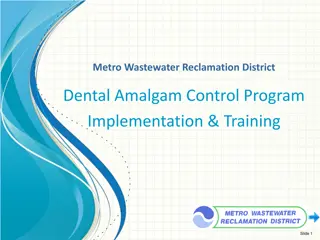Comprehensive Overview of Complex Amalgam Restoration in Conservative Dentistry
In the field of conservative dentistry and endodontics, complex amalgam restoration plays a crucial role in restoring teeth with multiple surfaces affected. This presentation delves into the indications, advantages, mechanical aspects, and considerations involved in performing complex amalgam restorations, providing valuable insights for dental learners and professionals alike.
Download Presentation

Please find below an Image/Link to download the presentation.
The content on the website is provided AS IS for your information and personal use only. It may not be sold, licensed, or shared on other websites without obtaining consent from the author.If you encounter any issues during the download, it is possible that the publisher has removed the file from their server.
You are allowed to download the files provided on this website for personal or commercial use, subject to the condition that they are used lawfully. All files are the property of their respective owners.
The content on the website is provided AS IS for your information and personal use only. It may not be sold, licensed, or shared on other websites without obtaining consent from the author.
E N D
Presentation Transcript
RUNGTA COLLEGE OF DENTAL SCIENCES & RESEARCH TITLE OF THE TOPIC: COMPLEXAMALGAM RESTORATION DEPARTMENT OF CONSERVATIVE DENTISTRY AND ENDODONTICS 1
Specific learning Objectives At the end of this presentation the learner is expected to know ; Core areas* Domain ** Category # RESISTANCE AND RETENTION FORM COGNITIVE MUST NOW INDICATIONS AND CONTRAINDICATION ADVANTAGES AND DISADVANTAGES PSYCHOMOTOR NICE TO KNOW TYPES OF AMALGAM RESTORATION AFFECTIVE DESIRE TO KNOW 2
CONTENTS Introduction Indications and contraindications Factors to be considered. Advantages and disadvantages Pin retained amalgam restorations Tooth preparation for pin retained amalgam restorations Retentive pins Mechanical aspect of pin retained restoration
INTRODUCTION INTRODUCTION Historically, the term complex amalgam restoration referred to one that involved three or more surfaces of a tooth. The term has been redefined in recent years to refer to an amalgam restoration that replaces one or more cusps When a cuspal-coverage restoration is indicated, a gold alloy casting is considered by many to be the restoration of choice. Newer ceramic materials with high strength and wear resistance also represent viable options for these restorations. However, for various reasons, an indirect material cannot always be chosen as the definitive restoration. In these situations, amalgam is an excellent alternative restorative material.
DEFINITION DEFINITION Complex posterior restorations are used to replace missing tooth structure of teeth that have fractured or are severely involved with caries or existing restorative material.( Sturdevant s) These restorations usually involve the replacement of one or more missing cusps , and often, they utilize a bonding technique.
FACTORS DETERMINING THE APPROPRIATENESS FACTORS DETERMINING THE APPROPRIATENESS OF A COMPLEX RESTORATION OF A COMPLEX RESTORATION Resistance and retention forms When conventional retention features are not adequate because of insufficient tooth structure, pins, nonpin mechanical features, amalgam bonding techniques may be used to enhance retention form. They also provide additional resistance form to the restoration.
Status and prognosis of the tooth A tooth which is grossly decayed that may require endodontic therapy or crown lengthening or that has an uncertain periodontal prognosis is often treated initially with a control restoration, which helps to: Isolate the pulp from the oral cavity Provide an anatomic contour against which the gingival tissue may be healthier Facilitate control of caries and plaque Provide some resistance against tooth fracture
Role of the tooth in overall treatment plan Abutment teeth for fixed prosthesis may utilize a complex restoration as a foundation ie if adequate resistance and retention forms can be provided. For periodontal and orthodontic patients, the complex restoration may be the restoration of choice until the final phase of treatment when cast restorations may be preferred.
OCCLUSION, ESTHETICS AND ECONOMICS indicated as interim restorations for teeth that require elaborate occlusal alterations. When cost of the indirect restorations is a major factor for the patient, the complex direct amalgam restoration may be an appropriate treatment option. Age and Health of the patient For some geriatric and debilitated patients complex amalgam restorations may be the treatment of choice over the more expensive and time consuming restorations
Burgress was the first to consider pin retention from scientific point of view and he published his findings in 1915. Rationale for use of pins: Pins help to support the restorative materials and resist their dislodgment in teeth that have been severely damaged and weakened. Conventional cavity preparations in badly mutilated cases require removal of large amounts of tooth structure for obtaining retention and resistance forms
OCCLUSION, ESTHETICS AND ECONOMICS indicated as interim restorations for teeth that require elaborate occlusal alterations. When cost of the indirect restorations is a major factor for the patient, the complex direct amalgam restoration may be an appropriate treatment option. Age and Health of the patient For some geriatric and debilitated patients complex amalgam restorations may be the treatment of choice over the more expensive and time consuming restorations
INDICATIONS INDICATIONS When large amounts of tooth structure are missing, when one or more cusps need capping. When increased resistance & retention form is needed. Definitive final restoration Foundation restoration- abutment teeth for fixed prostheses may use a complex restoration Control restoration Interim restoration
CONTRAINDICATION CONTRAINDICATION 1) Patient with significant occlusal problems. 2) If tooth cannot be restored with a direct restoration because of anatomic and/or functional considerations. 3) Esthetically important areas.
ADVANTAGES ADVANTAGES 1) Conservative tooth preparation (compared to indirect or crown restoration) 2) Completed in one appointment. 3) Resistance & retention forms increased by use of pins, slots and bonding. 4) Economic
DISADVANTAGES DISADVANTAGES Dentinal micro fractures Preparing pinholes and placing pins may create craze lines or fractures and internal stresses in the dentin. Microleakage Amalgam restorations using cavity varnish exhibit microleakage around all types of pins Decreased strength of amalgam The tensile strength and horizontal strength of pin-retained amalgam restorations are significantly decreased
Resistance form is difficult to develop The complex amalgam restoration does not protect the tooth from fracture as well as an extracoronal restoration. Penetration & perforation increases the risk of penetrating into the pulp or perforating the external tooth surface Proper contours & occlusal contacts difficult to achieve
RETENTION AND RESISTANCE FORM RETENTION AND RESISTANCE FORM NON PIN MECHANICAL FEATURES AMALGAM BONDING PINS
NON PIN MECHANICAL FEATURES NON PIN MECHANICAL FEATURES Parallel or convergent walls. Box form. Flat pulpal and gingival floors. Grooves in proximal line angles. Dovetails. Reduction of undermined cusps. Coves/locks. Amalgapins. Slots.
Types of complex amalgam restoration Types of complex amalgam restoration 1) Pin retained 5. Amalgam amalgam foundations restorations 2) Slot retained 6. Amalgapins amalgam restorations 7. Bonded 3) Cove amalgam 4) Proximal lock
PIN RETAINED RESTORATION PIN RETAINED RESTORATION PIN: Miniature metal rods inserted in dentin to enhance mechanical retention of a restoration Definition :A pin retained restoration is defined as any restoration requiring the placement of one or more pins in the dentin to provide adequate resistance and retention forms. (According to Sturdevant)
PIN RETAINED RESTORATION PIN RETAINED RESTORATION PIN: Miniature metal rods inserted in dentin to enhance mechanical retention of a restoration Definition :A pin retained restoration is defined as any restoration requiring the placement of one or more pins in the dentin to provide adequate resistance and retention forms. (According to Sturdevant)
Burgress was the first to consider pin retention from scientific point of view and he published his findings in 1915. Rationale for use of pins: Pins help to support the restorative materials and resist their dislodgment in teeth that have been severely damaged and weakened. Conventional cavity preparations in badly mutilated cases require removal of large amounts of tooth structure for obtaining retention and resistance forms
Burgress was the first to consider pin retention from scientific point of view and he published his findings in 1915. Rationale for use of pins: Pins help to support the restorative materials and resist their dislodgment in teeth that have been severely damaged and weakened. Conventional cavity preparations in badly mutilated cases require removal of large amounts of tooth structure for obtaining retention and resistance forms
Pins provide efficient and adequate retention to the restorations with the least possible sacrifice of healthy tooth structure. With the use of pins, cavity preparation can also be limited to only damaged surfaces there by preserving esthetics and contours.
INDICATION INDICATION As auxiliary aids of retention in badly broken or mutilated teeth, large class II, Class III, IV, and Class V cavity preparations. As foundations for full or partial metal or metal ceramic restorations. As a cross linkage mode between two bulky, sound parts of the remaining tooth structure, which is discontinued by abnormal tooth involvement or cracks. In teeth with guarded prognosis i.e in endodontically and periodontally involved teeth.
ADVANTAGES ADVANTAGES Pins are used whenever adequate resistance and retention forms cannot be established with slots, locks, or under cuts only Pin retained amalgam is an important adjunct in the restoration of teeth with extensive caries or fracture Significantly greater retention
DISADVANTAGES DISADVANTAGES Craze lines, fractures, internal stresses in dentin Increases the risk of perforation in to the pulp or the external tooth surface Decreases the tensile strength of the pin retained amalgam restorations
TOOTH PREPARATION TOOTH PREPARATION The general concept similar to conventional amalgam restorations. CUSP CAPPING When caries is extensive, reduction of one or more of the cusps for capping may be indicated. When the facio lingual extension of the occlusal preparation exceeds 2/3rd the distance between the facial and lingual cusp
Depth cuts should be made on the remaining occlusal surface of each cusp to be capped side of a carbide fissure bur or a suitable diamond instrument. The depth cuts should be 2 mm deep for functional cusps and 1.5 nonfunctional cusps. Using the depth cut as a guide, the reductions is completed to provide for an uniform reduction structure. The occlusal contour of the reduced cusp should be similar to the normal contour of the unreduced cusp mm deep minimum for of tooth
Any sharp internal corners of the tooth preparation formed at the junction of the prepared surfaces should be rounded which reduce stress concentration in the amalgam improve its resistance to fracture from occlusal forces. When reducing only one of two facial or lingual cusps, The cusp reduction should be extended first past the facial or lingual groove creating a vertical wall against the adjacent unreduced cusp.
TAKE HOME MESSAGE TAKE HOME MESSAGE Because of its history, the complex amalgam restorations may be the most frequently placed complex restoration. However due to the increasing benefits of composites, the many types of auxiliary retention forms available, and the variations of tooth preparations required for complex restorations, the operator should be familiar with all of these techniques, if he or she is to use these restorations on a regular basis.
QUESTIONS TYPES OF AMALGAM RESTORATION INDICATION CONTRAINDICATION ADVANTAGES DISADVANTAGES
REFERENCES: 1. Sturdevant's Art and Science of Operative Dentistry - fourth Edition 2. Operative Dentistry - Modern theory and practice - First Marzouk Edition- M.A. 3. Text book of operative dentistry - Vimal K. Sikri 4.Fundamentals of Operative Dentistry- Summit JB- 2nd edition 5.Text book of operative dentistry nisha carg,amit carg 6.Principles and Practice of Operative Dentistry-Gerald T. Charbeneau-Third edition. 7.Clinical operative dentistry-principles and practice ramya Raghu,Raghu sreenivasan



